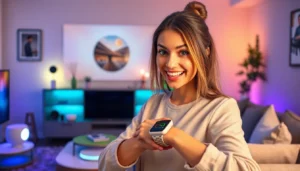In a world where memes rule the internet and cat videos reign supreme, mental health matters images are the unsung heroes of emotional well-being. They pack a punch of positivity and can turn a frown upside down faster than you can say “self-care.” These images aren’t just pretty pictures—they’re powerful tools that spread awareness, spark conversations, and remind us that it’s okay not to be okay.
Imagine scrolling through your feed and stumbling upon a vibrant graphic that makes you chuckle while also hitting home. That’s the magic of mental health images. They blend humor with heart, making it easier to discuss serious topics. So, let’s dive into the colorful world of mental health matters images and discover how they can uplift spirits, break stigma, and maybe even inspire a few giggles along the way.
Table of Contents
ToggleUnderstanding Mental Health Matters Images
Mental health matters images play a crucial role in fostering emotional well-being. These visuals effectively communicate messages about mental health, encouraging open discussions and awareness.
Importance of Visual Representation
Visual representation carries significant weight in mental health advocacy. Images can simplify complex concepts, making them more relatable. They encourage individuals to acknowledge their feelings and seek help. Engaging visuals capture attention, allowing for critical conversations to flourish. Consequently, these images help in breaking the stigma surrounding mental health issues. Community connection often strengthens through shared visual experiences. Creating empathy and understanding, these representations contribute to a more supportive society.
Types of Images Related to Mental Health
Diverse types of images highlight various aspects of mental health. Infographics can present statistics and information in an easily digestible format. Illustrations serve to depict emotions and relatable situations, allowing viewers to connect on a personal level. Inspirational quotes often accompany uplifting visuals, promoting positivity and hope. Memes combine humor with serious topics, encouraging sharing and conversation in a light-hearted way. Photographs showcase authentic experiences, providing visibility to real-life struggles and triumphs. Each type of image contributes to a comprehensive understanding of mental health matters.
Impact of Mental Health Matters Images

Mental health matters images significantly influence emotional well-being in today’s digital landscape. They engage audiences and empower individuals to confront mental health issues openly.
Emotional Engagement Through Imagery
Imagery evokes emotions and reinforces connections to mental health themes. Captivating visuals resonate with viewers, making it easier for them to reflect on personal experiences. Colorful designs and relatable scenarios draw attention and foster empathy. By integrating humor and inspiration, images make serious topics more approachable. Engaging elements create a sense of community, encouraging individuals to share their struggles. Overall, visual content cultivates an environment where people feel comfortable discussing mental health.
The Role of Art in Mental Health Awareness
Art serves as a vital medium in mental health awareness campaigns. Creative expression captures complex emotions, enabling deeper understanding among audiences. Illustrations, photography, and infographics communicate messages that statistics alone cannot convey. Artists often share personal journeys, reinforcing the importance of authenticity. Through their work, artists provide visibility and relatability, inspiring conversations about mental health. Collaborative projects amplify voices and foster connections, building supportive networks that promote healing.
Platforms for Sharing Mental Health Matters Images
Social media serves as a primary platform for sharing mental health matters images, creating accessible spaces for dialogue. Users leverage channels such as Instagram, Facebook, and Twitter to post visuals that resonate with diverse audiences.
Social Media Influence
Visual content on social media amplifies the message of mental health awareness. Instagram posts that feature quotes over calming backgrounds reach thousands instantaneously. Memes spread quickly across platforms, often blending humor with serious concerns, allowing individuals to connect with challenging topics in a lighter manner. Content creators shape discussions by sharing personal experiences and curated images that inspire followers. As a result, shared imagery fosters community engagement around mental health matters, encouraging open conversations and subsequent support.
Community and Support Groups
Community and support groups utilize images to create a sense of belonging. Online forums and local meet-ups rely on visuals to convey shared experiences and offer reassurance. Members often upload imagery to represent their struggles and triumphs, creating strong emotional bonds. Infographics clarify resources available for mental health, making information digestible for participants. These shared interactions through images build empathy and understanding, reinforcing the collective mission of breaking stigma and improving mental well-being. Through these platforms, individuals find comfort in knowing they are not alone in their journeys.
Creating Your Own Mental Health Matters Images
Creating mental health matters images can empower others and raise awareness. Individuals can use several effective strategies.
Tips for Capturing Relatable Imagery
Focus on authenticity when capturing images. Real emotions resonate more with audiences. Incorporate candid moments to illustrate genuine experiences. Use diverse subjects to represent various backgrounds and mental health journeys. Aim for visuals that promote connection and understanding. Color palettes impact feelings; bright colors evoke positivity, while softer tones can convey calmness. Invite subjects to share their stories, lending sincerity to the imagery.
Tools and Resources for Image Creation
Leverage various tools to create engaging images. Canva offers user-friendly graphic design options for beginners and professionals. Adobe Spark provides advanced customization capabilities for unique visuals. Stock photo websites, like Unsplash and Pexels, offer high-quality images that are free to use. Free editing software, such as GIMP or Pixlr, enhances photos with filters and effects. Explore design tutorials available on platforms like YouTube, where creators share tips on crafting powerful visuals.
Conclusion
Mental health matters images play a vital role in shaping conversations around emotional well-being. Their ability to combine humor and heartfelt messages makes serious topics more approachable, fostering understanding and empathy. By utilizing various visual formats, these images not only break stigma but also create supportive communities.
As individuals engage with these visuals on social media platforms, they find connection and comfort in shared experiences. This collective approach to mental health advocacy encourages openness and inspires others to seek help. Ultimately, the impact of mental health matters images extends beyond mere visuals; they empower individuals to embrace their journeys and promote healing in a society that values emotional well-being.





